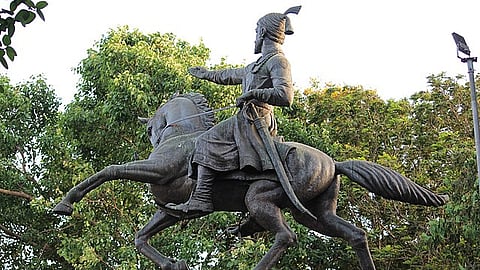
- Destinations
- Experiences
- Stay
- What's new
- Celebrating People
- Responsible Tourism
- CampaignsCampaigns
- SubscribeSubscribe
- Buy Now

Chhatrapati Shivaji Maharaj's 'wagh nakh,' currently on display in the UK's Victoria and Albert Museum (V&A), is set to return to India as UK officials have consented to release it to India.
Sudhir Mungantiwar, Maharashtra's Cultural Affairs Minister, is expected t visit London later this month to sign a memorandum of understanding (MoU) with the Victoria and Albert Museum.
It is believed that the weapon was wielded by Shivaji in 1659. The Maratha chieftain is said to have used the wagh nakh, an iron weapon curved like tiger claws, to kill Bijapur sultanate general Afzal Khan.
Mungantiwar told ANI that Chhatrapati Shivaji Maharaj's wagh nakh will be brought to the country in November, after a memorandum of understanding is signed in London in October.
About The Weapon
The wagh nakh is a small dagger-shaped tiger claw. Its design was inspired by the claws and nails of the tiger. It is worn across the knuckles or buried beneath and against the palm.
The dagger has four or five curved blades that are similar to tigers' nails and leave deep cuts on flesh and muscles.
The V&A website lists the small weapon, describing it in some detail—steel tiger claws, bagh nakh, a weapon designed to be concealed in the palm of the hand. It has four ‘claws’ mounted on a bar with two rings for the first and fourth fingers. The difference in size between the two rings indicates that it is a weapon to be used in the left hand.
"This weapon belonged to James Grant Duff (1789- 1858), an officer of the East India Company who was appointed Resident (political agent) of the Satara State in 1818. The weapon is accompanied by a fitted case, made after Grant Duff returned to Scotland, that is inscribed: "The 'Wagnuck' of Sivajee With Which He Killed the Moghul General. This Relic was given to Mr. James Grant-Duff of Eden When he was Resident at Satara By the Prime Minister of the Peshwa of the Marathas". This refers to a famous moment during the complicated political upheavals of 17th-century India.
During a protracted military engagement in 1659, the Maratha leader Shivaji and Afzal Khan, the commander of the opposing Bijapur army, arranged a truce in order to meet in a tented enclosure, virtually alone. Both came armed: Shivaji wore mail under his clothes and metal skull protection under his turban. He also held a metal ‘tiger claws’ weapon concealed in his hand. The two men fought, and Shivaji disembowelled his opponent. The last Peshwa (Prime Minister) of the Marathas, Baji Rao II, surrendered to the British in June 1818 after defeat in the Third Anglo-Maratha War and was banished to Bithoor near Kanpur. It is possible he also surrendered this weapon to Grant Duff. It has not been possible to verify whether these tiger claws are the ones used by Shivaji nearly 160 years earlier."
